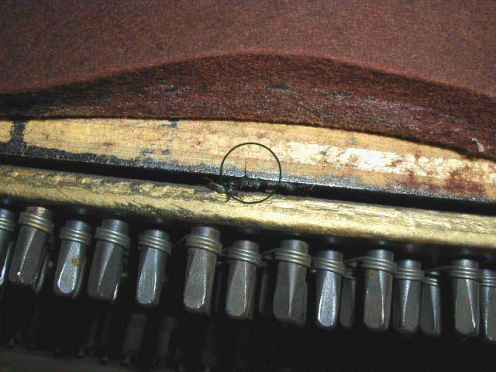CRACKED PIN BLOCK!

This is the most elusive henchman of Basket Cases. As mentioned
earlier, pin blocks are rarely visible. There is actually
no piano that has ever been made where the complete pin block IS
visible.
This picture shows a glimpse of the pin block's top view. It
is visible because we tore the factory-glued felt away from the
pin block to catch a look at it. There's a sure way to be
removed from a home or showroom! This confirmed our suspicion
why certain tuning pins were much looser than others. The
pin block is riddled with these cracks. While this one only
went through one of the block's laminations, it is suspected that
others which could not be viewed penetrated several or all laminations.
This represents a complete fatality. The piano will never
hold a tune again. Pin block replacement is really only an
option in grand pianos, since the eventual resale value of a grand
will likely allow for a multi-thousand dollar repair (like a replaced
pin block). Money Pit Example #4.
There is only one atrocity worse than a cracked pin block, and
that's a cracked plate.
When there's a crack in the plate, you also have a potentially dangerous situation if it is in a strut. Pianos with
cracked plates can actually explode. This is EXTREMELY RARE,
but it can happen and has happened. Click the link above for a picture.
With up to 60,000 lbs. of pressure being stretched across its cast
iron plate, a crack in the strut of an iron plate significantly
weakens the frame. That pressure wants to go somewhere. After
all, it's the pressure that caused the crack in the first place.
A piano with a cracked plate should immediately have the string
tension released and should be permanently relieved of its duties.
It poses no danger as long as there is no tension on the strings.
|